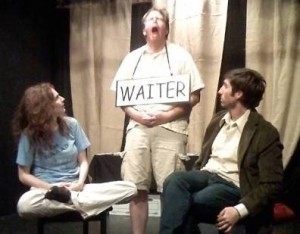
He called her Gilbert. She called him Zweibel, accent on the “bel.” She became
one of the most famous, funniest, and most beloved comediennes of the 1970s.
He wrote for the TV show that made her a star and later co-created a hit TV
sitcom. They loved each other for fourteen years, though each married
another. They were the best of friends until her untimely death. She was Gilda
Radner. He is Alan Zweibel. Bunny Bunny is the beautifully funny, affectionately
written, and exquisitely directed and performed “sort of romantic comedy” of
two lives intertwined.
Lovely Elisa Morse downplays her beauty and upplays (?) her quirky comedic
charm in a terrific performance that pays loving (and comic) tribute to the
divine Miss R without ever becoming imitation or caricature. She has Gilda’s all-
over-the-place hair and trademark suspenders and slacks and a smile that lights
the little Hudson black box brighter than any of the lights from above. And in
two pantomime sequences (as Zweibel recounts them to the audience) she is
magical as Roseanne Rosannadanna and later as Gilda doing her final sketch
on SNL.
Michael Cotter is Saturday Night Live writer Alan Zweibel, in a performance
every bit Morse’s equal. Like David Schwimmer, Jason Biggs, and Henry Winkler
(circa Fonzie), Cotter combines a unique kind of dark good looks with slightly
goofy comic charm that proves irresistible to Gilda and to the audience. Cotter
has wonderful chemistry with Morse, the two of them forming a couple that the
audience can’t help but want together. (And this is an actor with major
Shakespeare credits to boot.)
Bill Glass is the only other performer on stage (in fact, all three actors rarely leave
the stage for even a moment) and he plays to the hilt all the other parts, 30 in all
I’m told, including: a speech impaired waiter, a TV camera, a girlfriend, an
Italian fishmonger, a door, a naked man, a train conductor, Andy Warhol, a
gaggle of Gilda fans, a broken hearted girlfriend, a South Asian cabbie, Zweibel’
s bride, Gilda’s first groom, and John Lennon in an elevator (in one of the
evening’s most hilarious, and apparently true scenes). A comic tour de force.
All three actors have worked together in improv with ingenious director Todd
Stashwick and assistant director Oliver Oertel, and their training, ease with
comedy, and ability to transform themselves into other people shows. Stashwick
has taken what must already have been an excellent script (by Zweibel) and
made it even better with his inspired choices, such as a virtually propless stage
on which a potted plant and a TV camera are merely signs on a stick saying
“POTTED PLANT” or “TV CAMERA.” The focus, as it should be, is always on the
two lead actors and the very real people they are playing.
Gilda and Zweibel meet cute and share an instant connection at a Saturday
Night Live audition, when she asks, “Can you help me be Julie Andrews’
parakeet?” leading to a very funny skit in which Gilda and an imaginary
parakeet sing a duet, which begins with the opening of Do Re Mi from The
Sound of Music and ends with Ike and Tina’s Rollin’ on the River. Zweibel (or is it
Gilda?) is “sort of not really seeing someone” and the other just got out of “sort of
not seeing someone.” No matter. Soon a friendship begins, which promptly turns
to love. Gilda tells Zweibel, though, that “You’re a guy and guys leave me,” and
in order to preserve their friendship, ends their romance. The friendship, however,
endures.
Highlights among the many hilarious scenes include watching Gilda help Zweibel
pay back his high school nemesis, a scene which features Gilda in a Meg Ryan in
When Harry Met Sally moment; Zweibel doing his best to tick Gilda off by
proposing a “series of sketches…over a very…very long period of time…for Laraine
(Newman)”; and Morse as Gilda singing Let’s Talk Dirty to the Animals, from Gilda
Live. But the play is not all fun and laughter. There is Gilda’s long struggle with
bulimia, a touching scene in which she tells Zweibel “I wish I didn’t have to be
funny to get people to love me,” and of course, her final, courageous battle with
ovarian cancer.
One of director Stashwick’s inspirations was to ask improv vet, Joe Lima, to
provide a running background musical score…on the tenor ukulele, just the
instrument to add a light comical touch to the action. Lima, seated downstage
throughout the show, sets the mood for each scene with, for example, a bit of
the Godfather theme for a movie theater sequence and later Anatevka from
Fiddler on the Roof, for Gilda and Zweibel’s final exit from the NBC studios after
their last SNL episode.
The play’s title Bunny Bunny, comes from back in Gilda’s childhood. To protect
herself “from the shadows,” “Bunny Bunny” were the first words that Gilda spoke
on the first of every month, all the way into her adult life. When Cotter, as
Zweibel, repeats these words with tears in his eyes on a bare stage just before
the final blackout, both he and the audience find themselves wishing Gilda
protection from the shadows, wherever her luminous spirit lives on.
Bunny Bunny is running on Tuesdays and Wednesdays at the Hudson Theater.
Since there’s very little else playing in town on those two nights, theatergoers
have no excuse whatsoever not to see this memorable gem of a production.
Hudson Guild Theatre, 6539 Santa Monica Blvd., Hollywood.
www.plays411.com/bunnybunny
–Steven Stanley
September 25, 2007




 Since 2007, Steven Stanley's StageSceneLA.com has spotlighted the best in Southern California theater via reviews, interviews, and its annual StageSceneLA Scenies.
Since 2007, Steven Stanley's StageSceneLA.com has spotlighted the best in Southern California theater via reviews, interviews, and its annual StageSceneLA Scenies.







 COPYRIGHT 2024 STEVEN STANLEY :: DESIGN BY
COPYRIGHT 2024 STEVEN STANLEY :: DESIGN BY